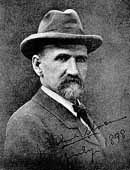I called the first part of this essay Part One (December 14) mostly because I wasn't sure where I was going with it. It is fine to say we are the Inheritors of the nautical tradition, but what do we do with that? I'm not sure, but I do know I like to teach younger folks how to navigate and run a ship, and sometimes - often - that means teaching them the old ways and why it was or is done that way.
On the cutter Steadfast we were rigging new monkey lines, the vertical man ropes the boat crew hold while the boat is being lowered, so if the falls let go the crew don't drop. The lines, ten to a boat and two boats, were one and 1/2 inch manilla, and they needed splicing and whipping. So I taught the deck gang how make an eye splice and how to sew a whipping. A sewn whipping in big three strand manilla is a pleasure to make and looks great, and whipping all those lines was a nice break from a needle gun and a paint brush. The guys liked it and I think it gave them some pride. Anchor drills and towing drills were similar opportunities to re-learn the old ways.
The junior quartermasters all learned in A School how to make a running fix and how to double the angle on the bow, but of course they forgot it pretty quick and they'd never done it on board. I worked with the chief, and the junior petty officers relearned those skills. Running along a coastline at a standard bell of 15 knots one can do those two fixes pretty rapidly and it is kind of magical how one can make a good fix off two lines of position derived from a single landmark. (Here's a nice illustration.) For that matter crossing the Gulf Stream's 4 knots from Florida to the Bahamas we retaught the concept of a DR (dead or deduced reckoning) plot and although they'd learned it in school it was satisfying for the petty officers to see, dramatically, how a DR plot and a fix are compared to give set and drift and a corrected course.
On watch we'd block off the gyrocompass repeater and the helmsman would steer by magnetic compass for minutes at a time. This was a little challenging because the magnetic compass was mounted a deck above and the helmsman saw the lubber line through a periscope, but one patrol the gyro suddenly crapped out and stayed bad for the trip and the guys were already comfortable steering by magnetic compass.
 On Journeyman we also show the kids the old ways and why it was or is done that way. We might also talk about Joshua Slocum and others, if a teachable moment occurs. In 1901 Slocum wrote a lively book of his circumnavigation (Sailing Alone Around the World) and he could be glib, but I defy any mariner to read his account of transitting the Straits of Magellan without becoming in awe of his abilities.
On Journeyman we also show the kids the old ways and why it was or is done that way. We might also talk about Joshua Slocum and others, if a teachable moment occurs. In 1901 Slocum wrote a lively book of his circumnavigation (Sailing Alone Around the World) and he could be glib, but I defy any mariner to read his account of transitting the Straits of Magellan without becoming in awe of his abilities.I hope these sorts of exercises, and many others, give young sailors a sense that others came before them. I know they do for me.
No comments:
Post a Comment
Note: Only a member of this blog may post a comment.